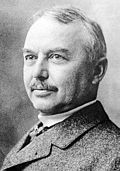| |||||||||||||||||
| |||||||||||||||||
 County results Clement: 50–60% 60–70% 70–80% 80–90% | |||||||||||||||||
| |||||||||||||||||
| Elections in Vermont |
|---|
 |
The 1918 Vermont gubernatorial election took place on November 5, 1918. Incumbent Republican Horace F. Graham, per the "Mountain Rule", [1] did not run for re-election to a second term as Governor of Vermont. Republican candidate Percival W. Clement defeated Democratic candidate William B. Mayo to succeed him.

